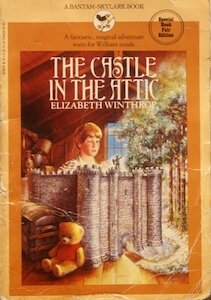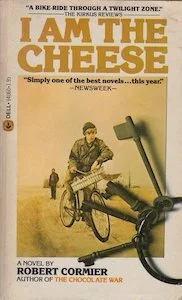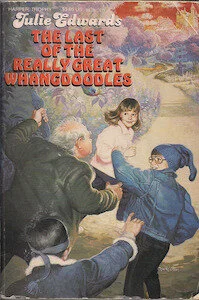7 Books From My Youth I’m Scared To Reread
As an indoor kid, I spent a lot of time with all various forms of escapist entertainment. One of the biggest was reading and consuming books. The Scholastic Book Club, a monthly newsletter offering various titles for students to purchase, was like a hand reaching down from nerdvana to offer me further solace.
There are so many titles from that period of my life (basically 1987-1993) that have shaped my sensibilities, thoughts on narrative, interests in stories, and more. I have so much fondness for those tomes, scenes and characters that still occupy space in my mind and heart. From time to time, I think about revisiting them, but I’m extremely hesitant.
These are books that are purposefully written for younger audiences, so there’s looser logic, increase in exposition, simplified vocabulary, and other ways to avoid further confusing tiny minds. But, even without those caveats, some have stood the test of time and remain solid reads. The Thief Of Always by Clive Barker, Lloyd Alexander’s The Prydain Chronicles, and Trouble In Bugland by William Kotzwinkle are still impressive and kind of work no matter the age.
But what if I check out these other titles, the formative texts that remain in my cerebral library, and find them to be awful? Not just in terms of problematic stuff from those decades, but simply terrible writing that proves how much of a fool I am. Sometimes it’s best not to go back; in other words, sometimes dead…is better. Here are seven books that I devoured as a kid that I’m very scared to revisit.
Beach House
by R.L. Stine
YA horror seems to be coming back in adaptation form with Netflix adapting Christopher Pike’s The Midnight Club and R.L. Stine’s Fear Street Saga for limited series. These books were my everything in junior high, though I was more of a Pike boy, if I’m being honest. Once Stine got more into Goosebumps and really only turning out those titles (of which I really only like the first two entries), I kind of tuned out even more. But Beach House was my jam. MY JAM, I SAYS! It was a book I read with the quickness and then got all of my other friends to check it out as well.
What stood out was the general nasty tone, graphic descriptions of violence/death, and a bizarre plot device that made for an imaginative take on the usual YA murder novels. I’m certain that twist would now play as convoluted and the grisly aspects are far tamer than I recall, so it may just remain untouched in mind.
The Castle In The Attic
by Elizabeth Winthrop
Why was miniaturization such a big thing in the ‘80s?
Think about it: The Indian In The Cupboard, INNERSPACE, Micro Machines toys, The Littles TV show, HONEY I SHRUNK THE KIDS, Polly Pocket toys, amongst others. Even though the shoulder pads were huge, people want stuff small. The Castle In The Attic features a young boy who gets a toy castle as a present, only to discover a tiny knight inside of it. They become friends while the boy is worried about his nanny leaving his parents’ employ—leading the kid to take drastic measures. It was pretty fun fantasy romp that surprisingly utilizes gymnastics as a key plot point. But the larger themes of growing up and letting go of childhood things resonates in an effective way that also involves an evil and disfigured wizard.
Tuck Everlasting
by Natalie Babbitt
I think Tuck Everlasting is probably still a perennial title for junior high curriculums. It fits into pre-teen lesson plans as it has not-so-subtle meditations on aging, morality, love, and family which are the backbone of life lessons that tend to be ubiquitous in those years. In addition to remaining in the reading list of many classrooms, Natalie Babbitt’s book has been adapted to film twice (1981 and 2002). So it’s probable that the 1975 story of an immortal family that lives in secret from the corrupt modern world holds up. And while I didn’t love it the first time I read it, I enjoyed Tuck Everlasting’s bittersweet melancholy that balanced romanticizing community with condemning the heart of darkness that lies inside most people.
I fear my current mind would nitpick everything; finding multiple plot contrivances and moral dilemmas that Babbitt unintentionally invited but had no interest in addressing.
I Am The Cheese
by Robert Cormier
Oh I Am The Cheese; you weird, half-assed book, you. Robert Cormier’s novel is this oddly surreal journey of a teenager on a bike as he tries to solve some mysteries, all while engaging bizarre characters that seemingly haunt his quest. It was turned into a movie in 1983, the sole directing credit for make-up artist Robert Jiras. The film starred Robert MacNaughton (the older brother in E.T.) as the lead, with Robert Wagner and Cynthia Nixon in supporting roles. I Am The Cheese really stood out in the eighth grade because it was packed with incredibly descriptive language, filled with a labyrinthine plot, and concluded with a huge twist. To be fair, I remember that, even then, I found the ending weak and didn’t make a lot of sense.
But the rest of the book still haunts me as this odd slice of kid lit filled with a pervasive sense of dread and paranoia that followed the protagonist everywhere he went. Cormier’s The Chocolate War, on the other hand, is still a solid book for all ages and Keith Gordon’s film adaptation is dope.
The Boy Who Reversed Himself
by William Sleator
There was a six month stretch in my pre-pubescent years where I read as many William Sleator titles as I could get my hands on. They were sci-fi mixed with horror, a dollop of teen angst, and an intriguing layer of What-The-Fuckery. Some—Fingers, The Duplicate—used familiar tropes while others—like Interstellar Pig and The House Of Stairs—were fairly bugnuts insane. The best way to describe Sleator’s vibe is a YA precursor for Harlan Ellison (but less misanthropic).
The Boy Who Reversed Himself is about kids that figure out how to traverse into another dimension that’s just like our own but a slightly mirrored reversal (coughcoughStrangerThingscoughcough). They discover some fun surprises in this other dimension (reversed ketchup is apparently delicious) as well as darker elements. I fear revisiting this because I think the basic mechanics and threats will be so arbitrary that I’ll be unable to conjure what about the book lured me in so much. Right now The Boy Who Reversed Himself exists in my head as a weird gonzo tale aimed at kids that perceived the world a bit differently themselves.
There’s A Boy In The Girls’ Bathroom
by Louis Sachar
Louis Sachar is best known for his Wayside School books, in which students get into various shenanigans at a kooky school filled with oddball teachers. But I preferred Sachar’s work that combined comedy with real pathos, like Dogs Don’t Tell Jokes and The Boy Who Lost His Face. They had the hallmarks of wacky moments and comedic interactions, but interspersed with scenes where the humorous characters also experienced real pain, confusion, and sadness.
There’s A Boy In The Girls’ Bathroom is a horrendous title that comes from basically one blundering scene. But it’s about this outsider who is fumbling his way through middle school, there are scenes where his (now abandoned) toys and stuffed animals lament being left behind and that the boy they once knew is leaving them (while also reenacting the boy’s own abandonment issues). Apparently this is a big theme I latched onto as a kid, and I worry that if I reread it, I would find it manipulative and trite and realize how much of angsty sad sack I’ve always been.
The Last Of The Really Great Whangdoodles by Julie Edwards
Here’s a fun fact: almost all of you are familiar with Julie Edwards’ work. Not necessarily in book form, but in other mediums like film and music. That’s because she’s Julie Andrews, who used the last name of her husband (Blake Edwards) when becoming an author. I believe that later editions used Julie Andrews, banking on the fame of the MARY POPPINS and THE SOUND OF MUSIC star.
Three siblings and a wily old professor embark on a phantasmagoric exploration of a fantasy world, encountering all manner of weird creatures who escaped the “real world” into this land to avoid humanity. They take multiple trips, hoping to find the titular creature, but are met at various turns by a shadowy figure who lays traps and obstacles for them. Whangdoodles was the book I thought Chronicles Of Narnia or The Phantom Tollbooth were going to be: flights of imagination into a spectacular world full of fun adventure and some nice character arcs.
Alack, the others just provided Jesus and grammar. The title, and multiple creatures in this land, were referenced in Roald Dahl works (and WILLY WONKA AND THE CHOCOLATE FACTORY), and yet there doesn’t seem to be any direct connection.
I loved this sweeping tale of fantastical events and wondrous beasts and think about it all the time, wishing to brush up on details I may have forgotten. But I think it’s more appropriate to not go back. The adventure is done and it remains in its own faraway land, preserved in ember for me to fondly remember instead of trying to recreate that magic.









